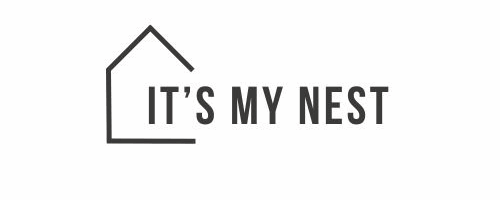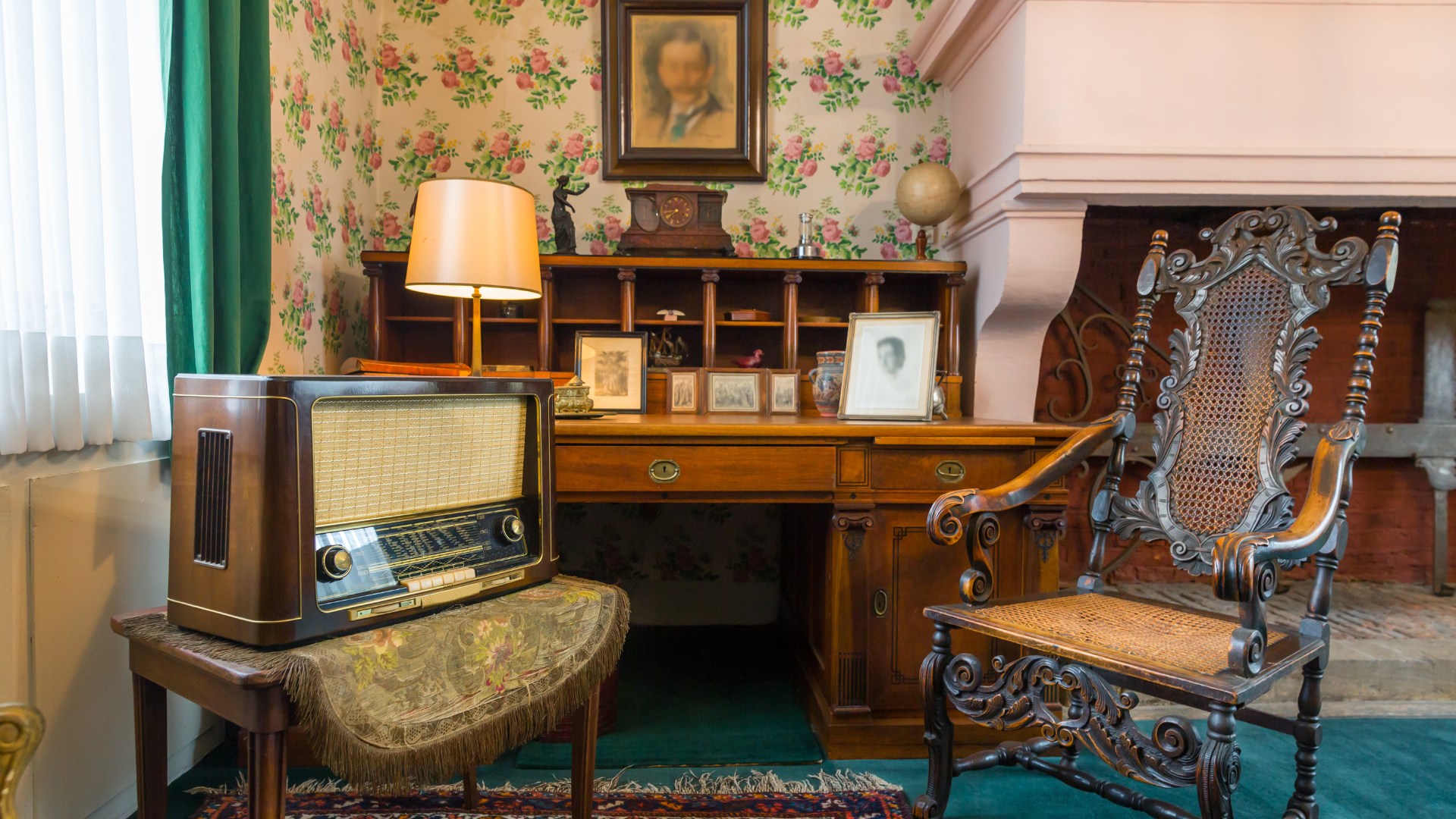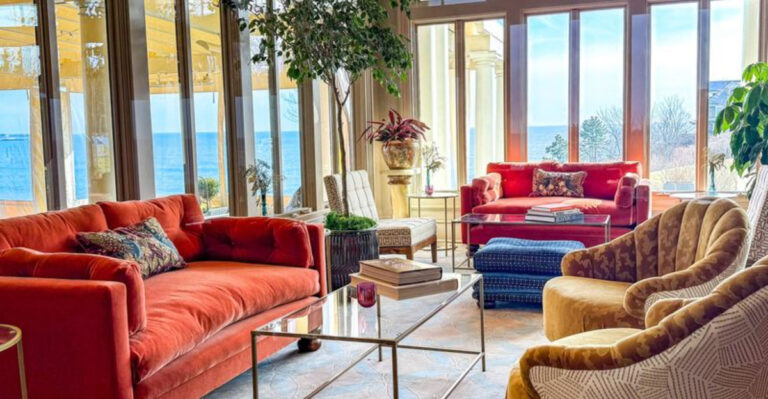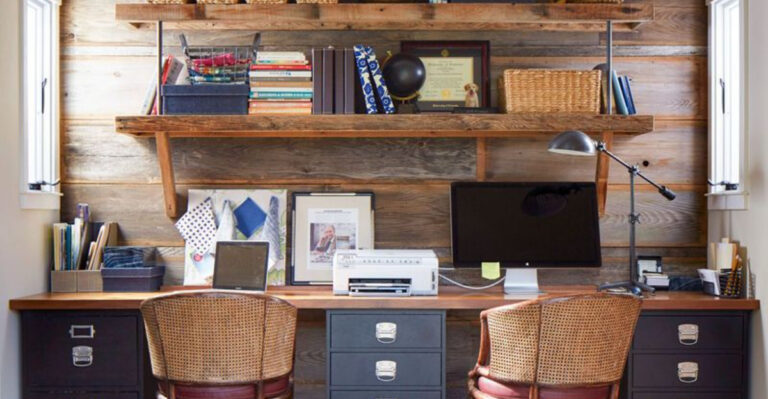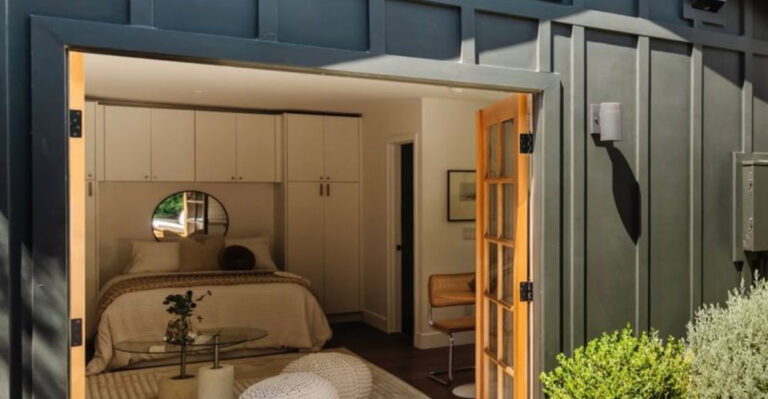40 Vintage Ways How 1980s Homes REALLY Looked Like
Ah, the 1980s. When neon was practically a neutral, and bold patterns were the height of home decor.
Think wall-to-wall carpet in shocking hues (yes, even in the kitchen), oversized furniture, and that weird but wonderfully funky obsession with geometric shapes. I remember my aunt’s living room.
Lime green walls with pink accents and those spiky plants that looked like they belonged in a sci-fi movie. This is a nostalgic celebration of the 80s, where every room feel like an adventure in design.
1. Popcorn ceilings
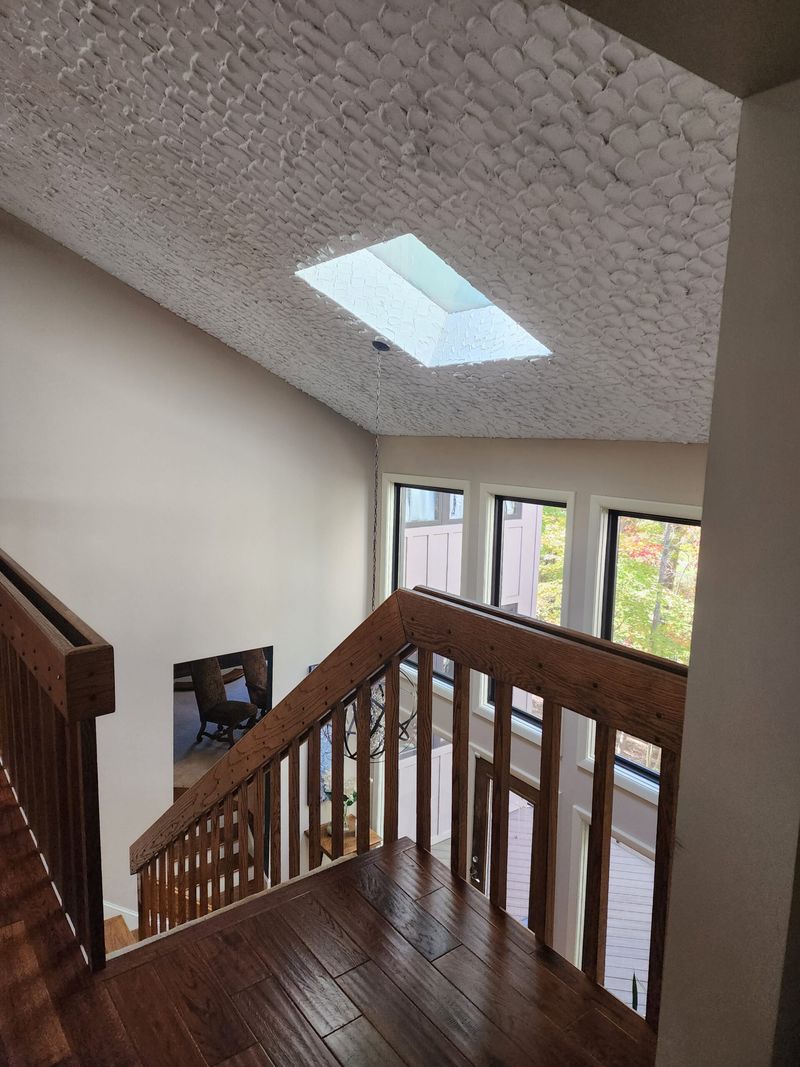
Stepping into a room with textured ceilings feels like entering another era. Popcorn ceilings, a hallmark of the 1980s, were celebrated for their acoustic dampening properties.
Usually painted white to reflect light, they added a subtle dimension to the room’s atmosphere. While these ceilings might seem outdated today, their distinctive texture was once considered the height of modern design.
Removing them can be a challenge, but embracing a popcorn ceiling can bring a vintage flair to a home.
2. Floral wallpaper
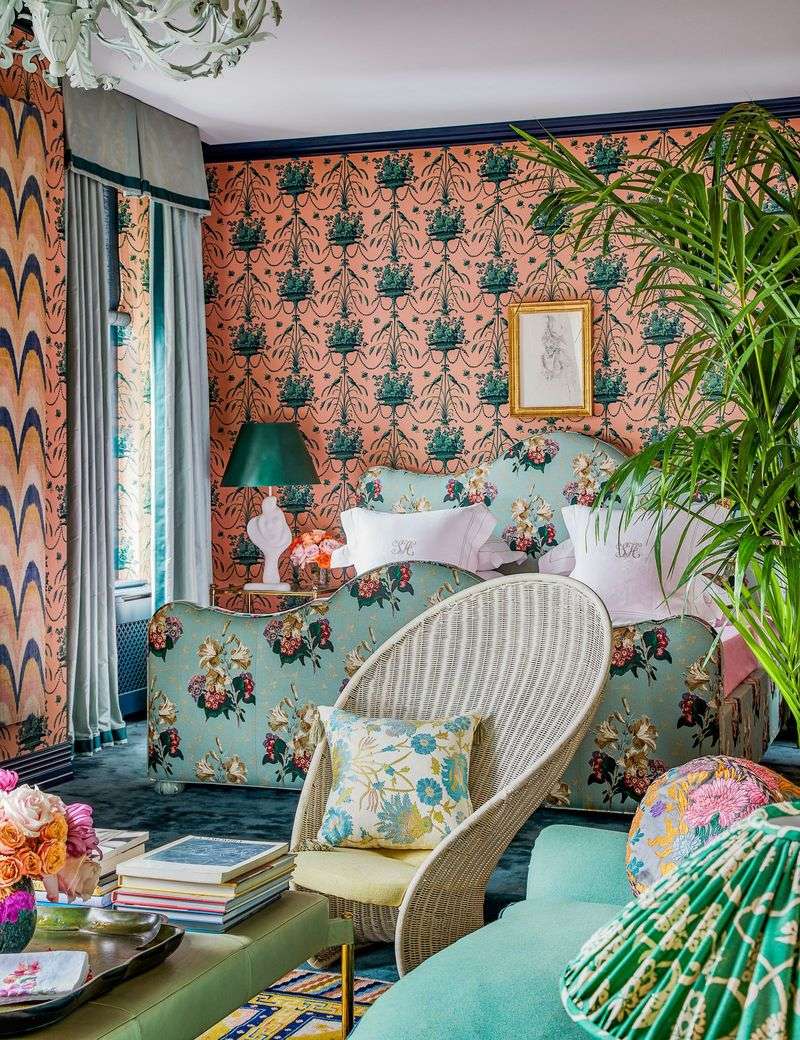
Floral wallpaper was synonymous with the 1980s design aesthetic. Walls adorned with oversized blooms in pastel or vibrant hues were common sights in many homes.
These patterns added warmth and personality to spaces, making them feel cozy and inviting. Often paired with wooden furniture, floral wallpaper was integral to the era’s interior design.
While it might not suit every modern taste, adding a wall of such bold prints can recreate a nostalgic retro vibe.
3. Wood paneling
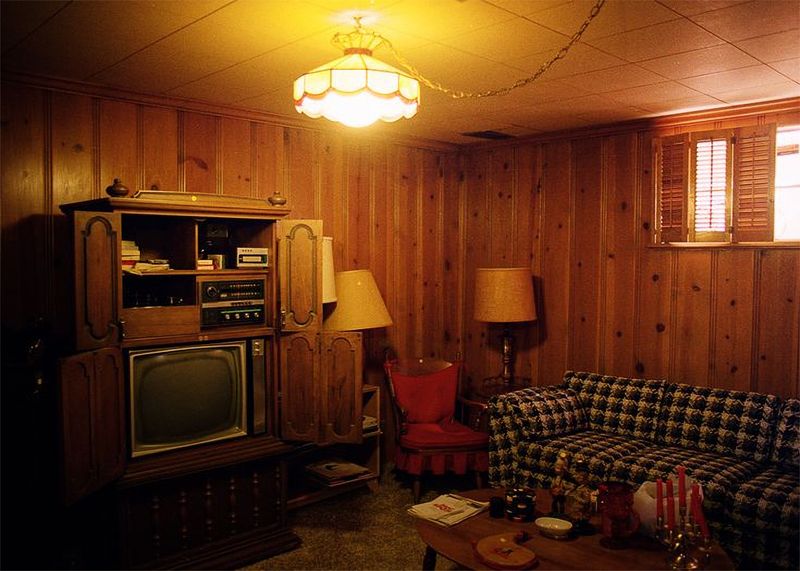
Entering a room with wood-paneled walls evokes a sense of warmth and nostalgia. In the 1980s, wood paneling was a popular choice, lending a rustic and homey feel to interiors.
Whether covering entire walls or acting as accents, it was a versatile design element. Today, some see it as outdated, while others appreciate its timeless charm.
Updating it with modern touches can blend past and present for a unique style.
4. Harvest gold appliances
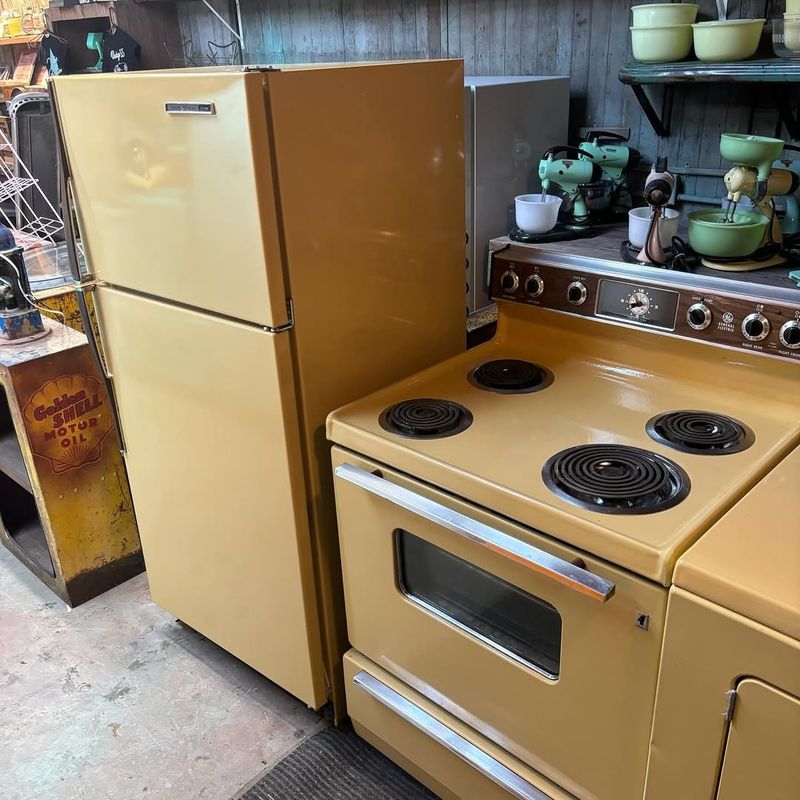
In the kitchen, the color palette spoke volumes. Harvest gold was a must-have hue for appliances in the 1980s, bringing a pop of color to the heart of the home.
This vibrant shade adorned refrigerators, ovens, and dishwashers, making them standout features. Even though this color might appear bold today, it was a stylish choice back then.
Introducing this color in small doses can add a retro vibe without overwhelming modern aesthetics.
5. Shag carpets
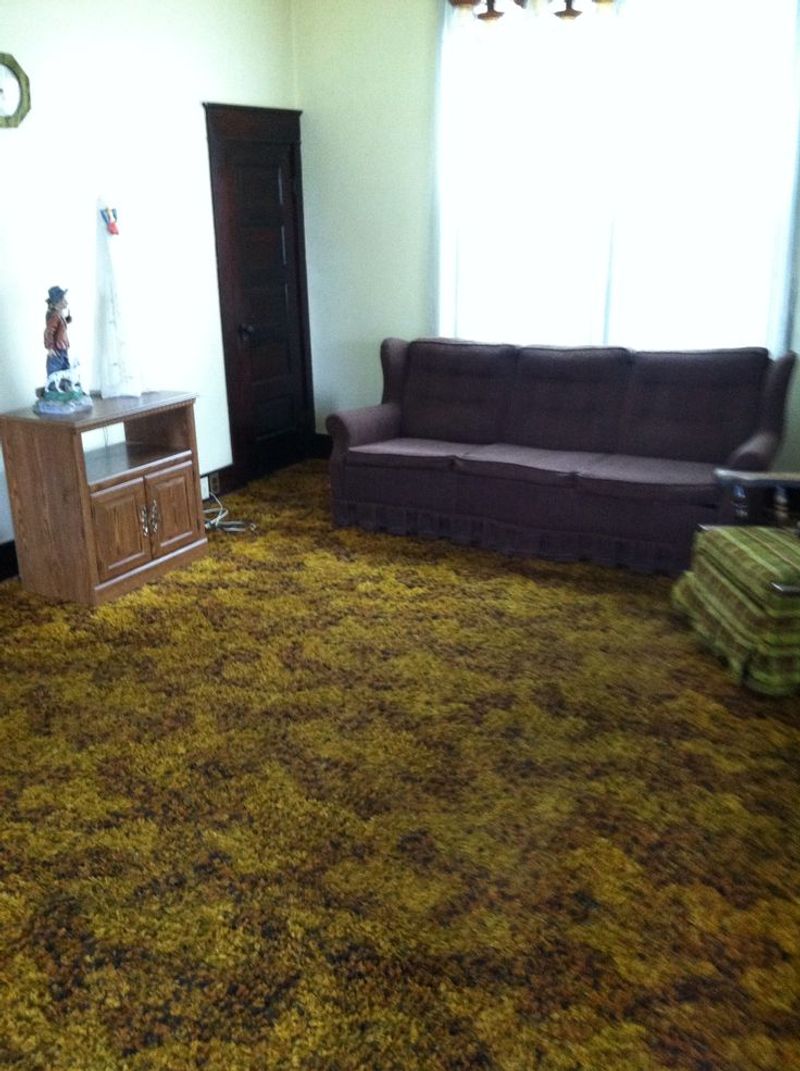
Walking across a plush carpet transports you back to the 1980s. Shag carpets, with their deep pile and soft texture, were a staple of the era’s interior design.
Often found in living rooms and bedrooms, they added comfort and warmth underfoot. The colors ranged from earthy browns to vibrant oranges, adding character to any space.
While not as popular today, a small shag rug can introduce a cozy, vintage vibe to modern decor.
6. Vaulted ceilings

The grandeur of vaulted ceilings was a striking feature in many 1980s homes. These ceilings created an open, airy feel, making rooms appear larger and more impressive.
Often paired with skylights or large windows, they allowed natural light to flood the space. While maintaining them can be challenging, their ability to enhance a room’s architecture is undeniable.
Vaulted ceilings remain a sought-after feature for those looking to add drama and elegance to their homes.
7. Dark oak furniture
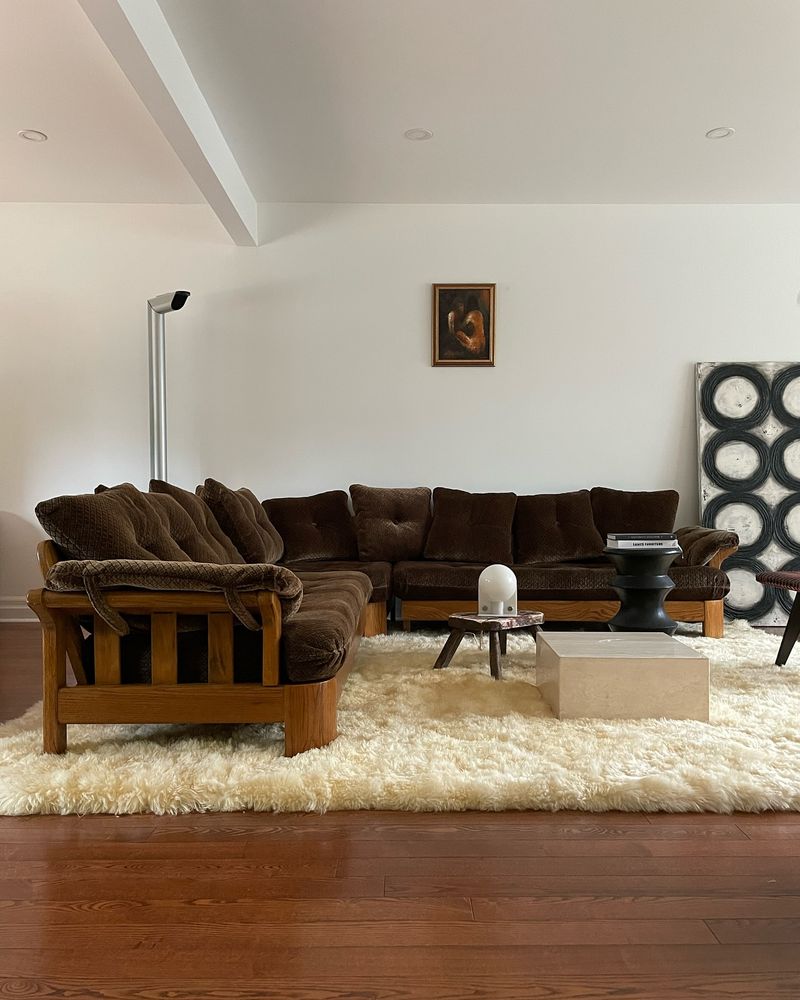
Dark oak furniture was a defining feature of the 1980s home. Rich and robust, it brought an element of sophistication and durability to interiors.
Dining tables, cabinets, and coffee tables crafted from this material were common. The deep color added warmth and anchored a room’s decor.
While tastes have shifted towards lighter tones, dark oak pieces can still be incorporated into modern designs for a classic vibe.
8. Faux wood beams
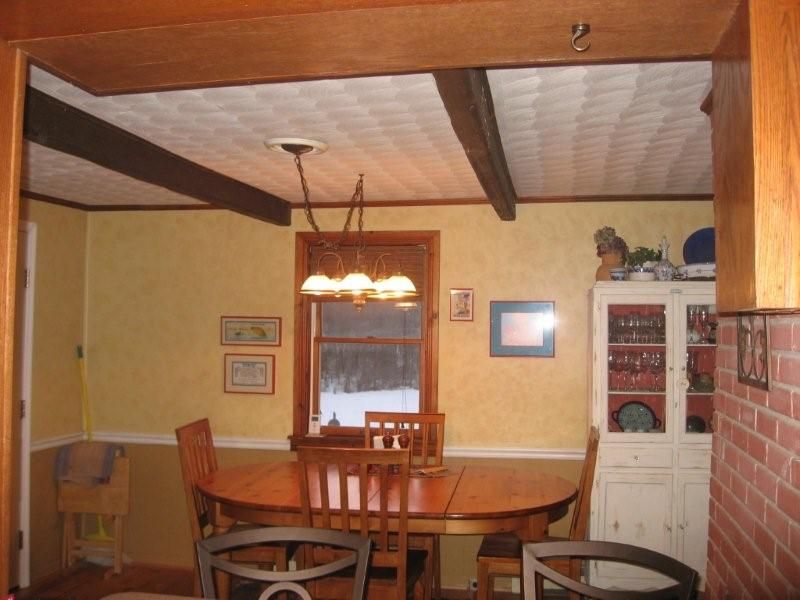
Ceiling beams add character to a room, and during the 1980s, faux wood beams were a popular choice.
These beams gave the appearance of solid wood without the weight or cost, making them a practical design solution. They were often used to create a warm, rustic ambiance, especially in living areas and kitchens.
While some may now find them outdated, they can still add charm and texture to contemporary spaces when used thoughtfully.
9. Formica countertops
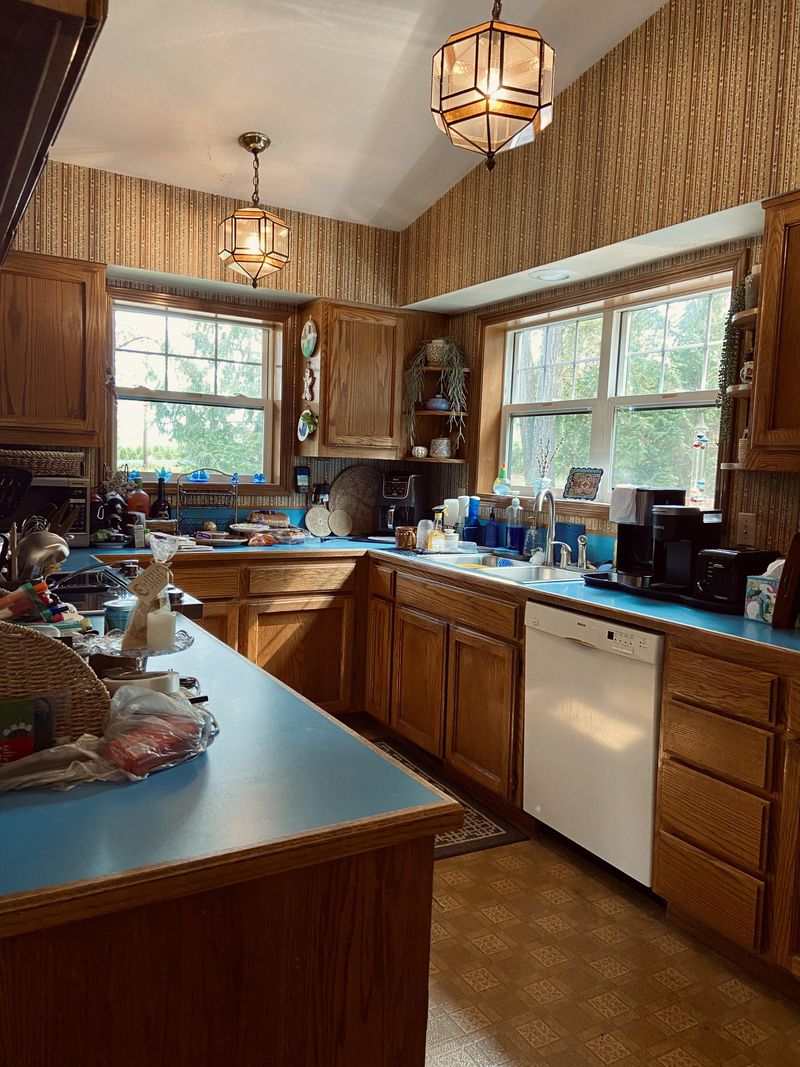
Kitchens in the 1980s often featured Formica countertops, known for their durability and vibrant designs.
These countertops came in a range of colors and patterns, from speckled neutrals to bright hues. They were a practical choice for busy households, easy to clean and maintain.
While granite and quartz are more popular today, Formica offers a budget-friendly option with a retro twist. Consider incorporating it for a touch of playful nostalgia.
10. Boxy furniture
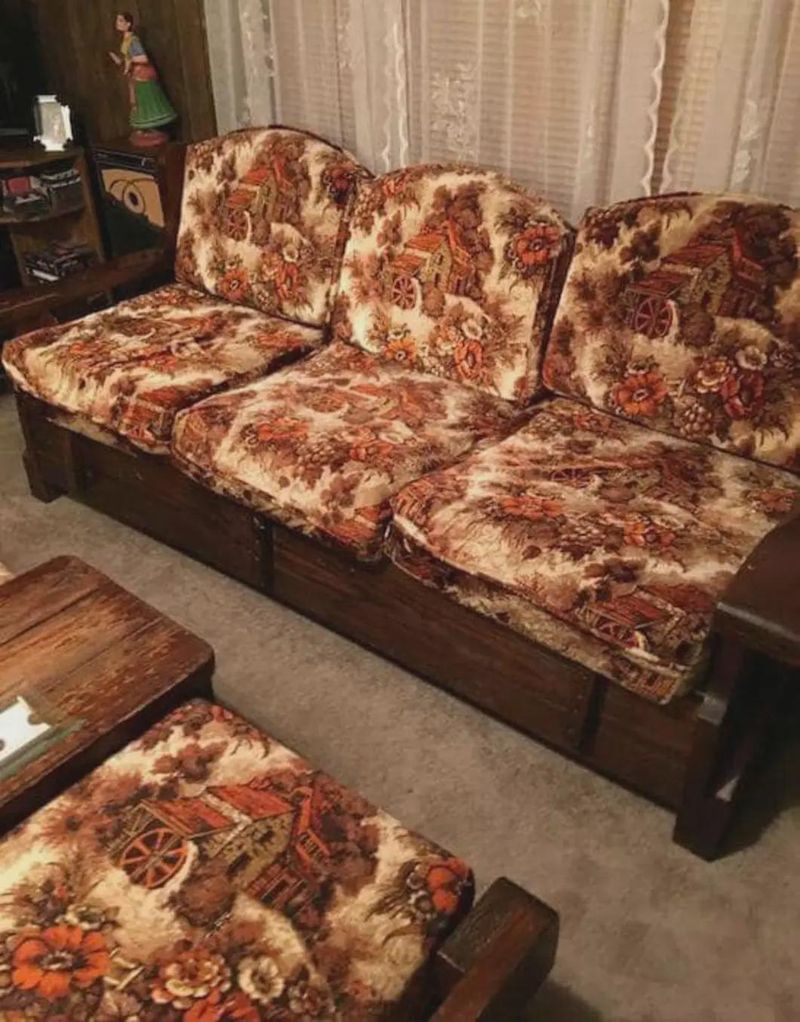
Straight lines and angular shapes were the order of the day. Boxy furniture defined many 1980s living rooms, offering a sleek and modern aesthetic.
Sofas, chairs, and tables favored geometric forms, creating a structured yet comfortable environment.
While trends have shifted towards more organic shapes, the boldness of boxy designs can still make a statement.
11. Mirrored accent walls
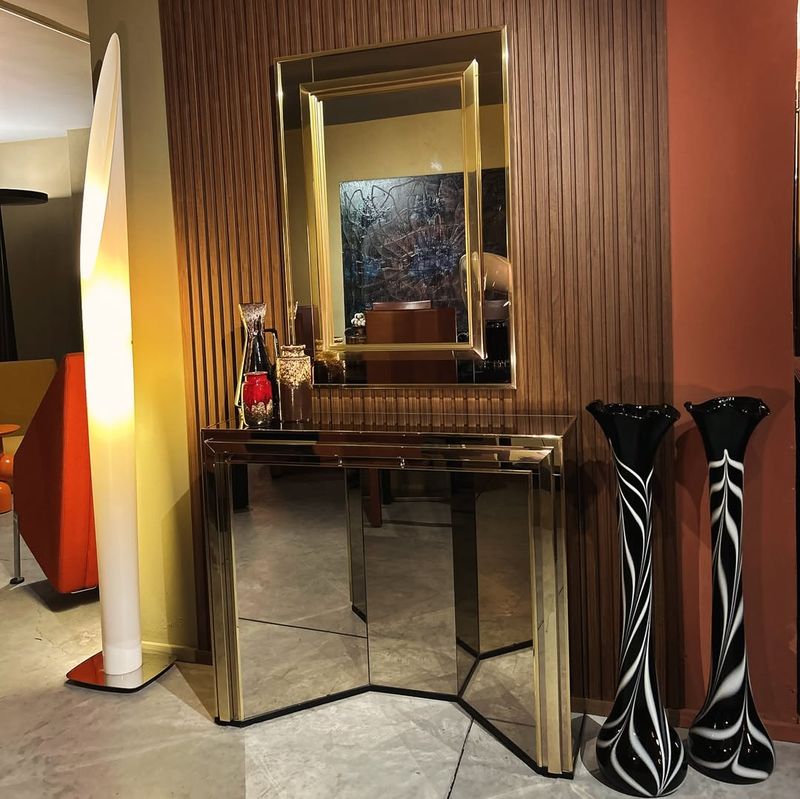
Mirrors have the magic to transform spaces, and in the 1980s, mirrored accent walls were all the rage. These walls enhanced the sense of space and light, making rooms feel larger and brighter.
Often found in dining rooms or entryways, they added a bit of glamour. While not as common today, a mirrored wall can still add a dramatic flair to modern interiors, reflecting personal style and creativity.
12. Overstuffed sofas

Comfort was king in the 1980s, and overstuffed sofas were the throne. These plush couches invited relaxation, with cushions you could sink into after a long day.
Often covered in patterned fabrics or luxurious velvets, they were a statement piece in living rooms. While modern designs lean towards sleekness, the comfort and coziness of an overstuffed sofa are hard to beat.
They remain a perfect choice for creating welcoming spaces.
13. Brass light fixtures
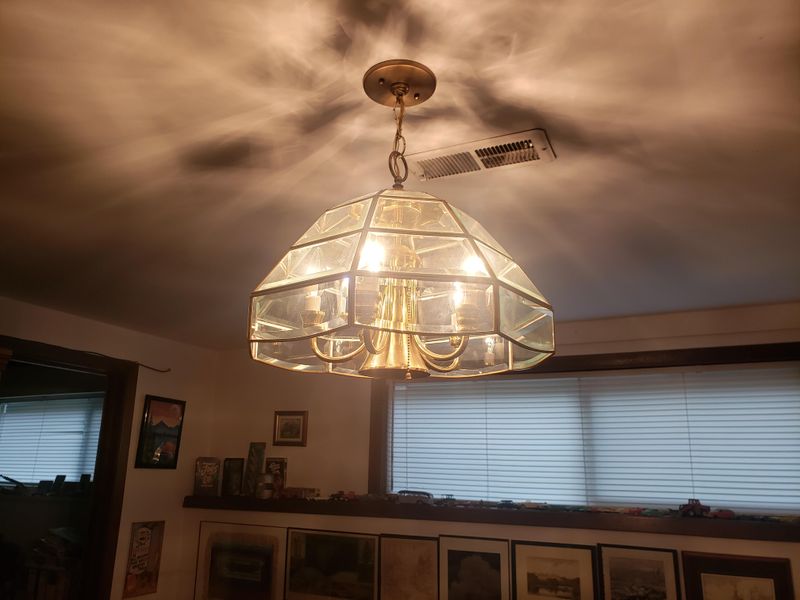
Lighting plays a crucial role in design, and in the 1980s, brass was a popular choice for fixtures. These metallic accents brought warmth and elegance to spaces, used in chandeliers, wall sconces, and lamps.
The golden hue of brass added a luxurious vibe, complementing both traditional and contemporary styles. While often replaced by more minimalist designs today, brass fixtures can still imbue a room with timeless charm and sophistication.
14. Geometric patterns
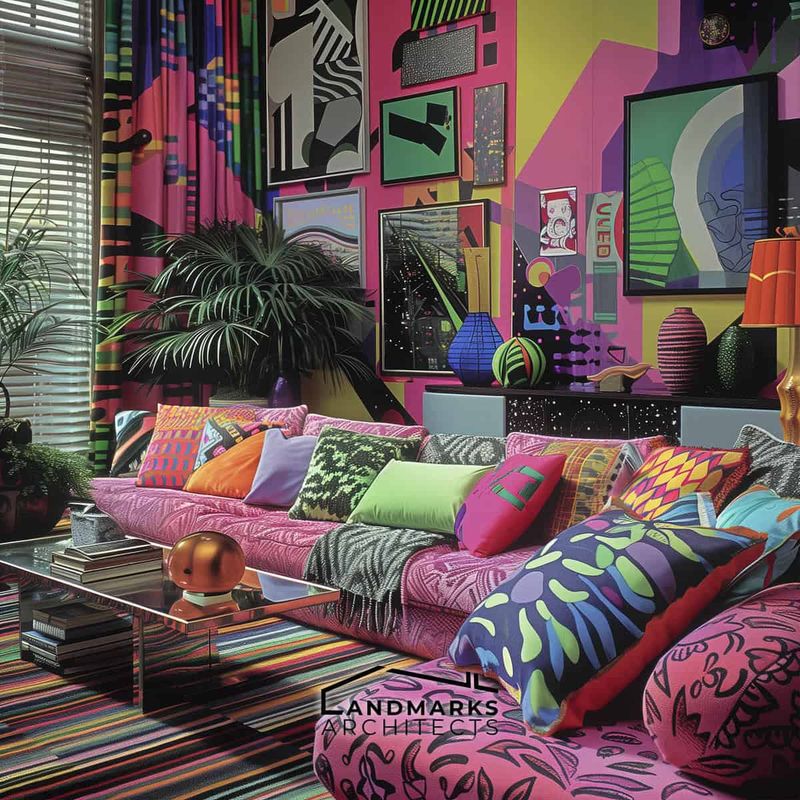
Patterns in the 1980s were anything but subtle. Geometric shapes dominated, from bold wallpapers to patterned textiles.
They added dynamic visual interest to rooms, creating eye-catching and energetic spaces. Whether in the form of triangles, circles, or abstract shapes, these patterns were a defining feature of the era’s aesthetic.
While not always in vogue today, a geometric design can bring a playful and modern retro vibe to contemporary settings.
15. Checkerboard floors
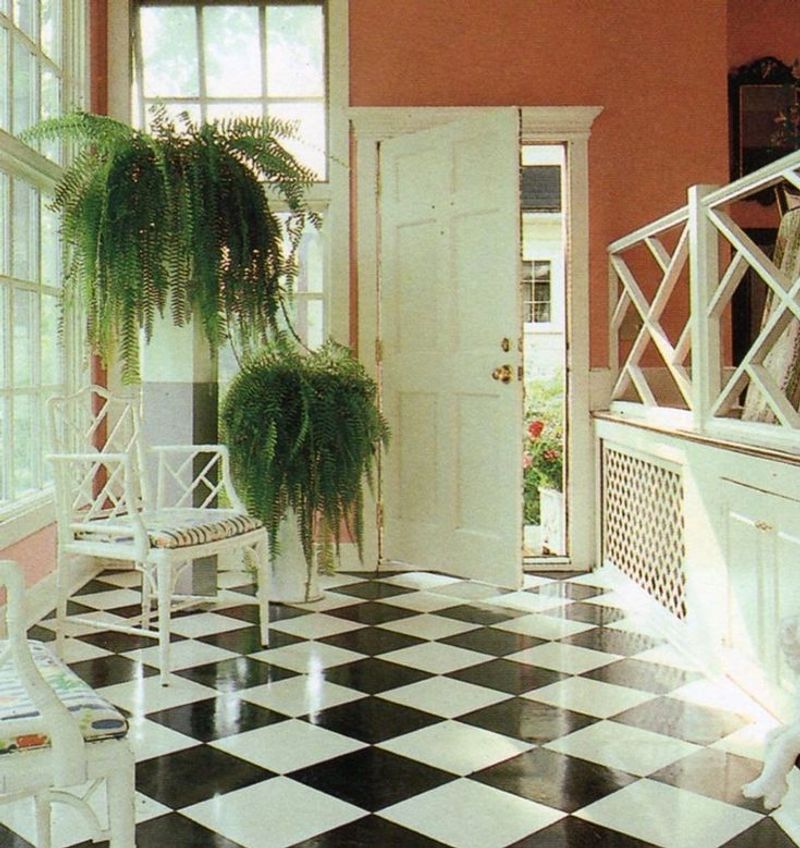
Stepping onto a checkerboard floor feels like stepping back in time. This classic design was a popular choice in 1980s kitchens and bathrooms, offering a bold and clean look.
The black and white tiles created a striking contrast that added character and charm to floors. While not as prevalent now, a checkerboard floor can still make a stylish and nostalgic statement, offering a timeless appeal that suits various design tastes.
16. Plastic plants
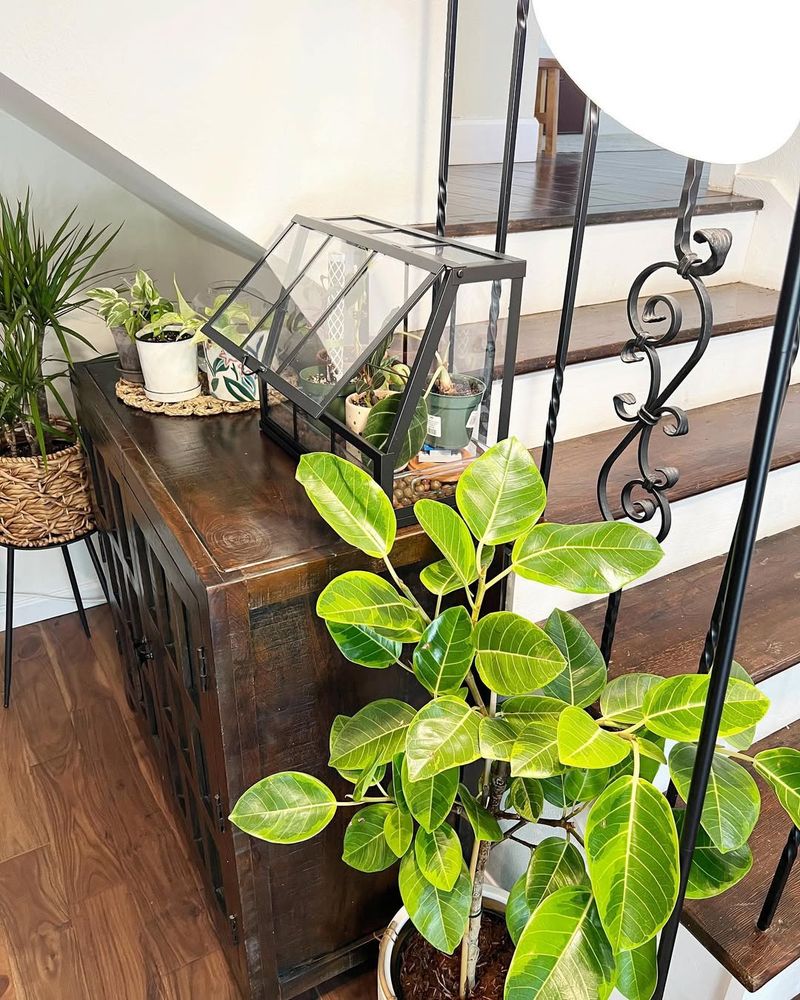
In a decade where convenience was key, plastic plants found their place in many homes. These faux botanicals offered the beauty of greenery without the upkeep, making them a practical decorative choice.
From ferns to palms, these plants added nature to interiors. While live plants are often preferred today, adding a high-quality faux plant can bring a bit of 1980s charm and low-maintenance greenery to a space.
17. Heavy drapes
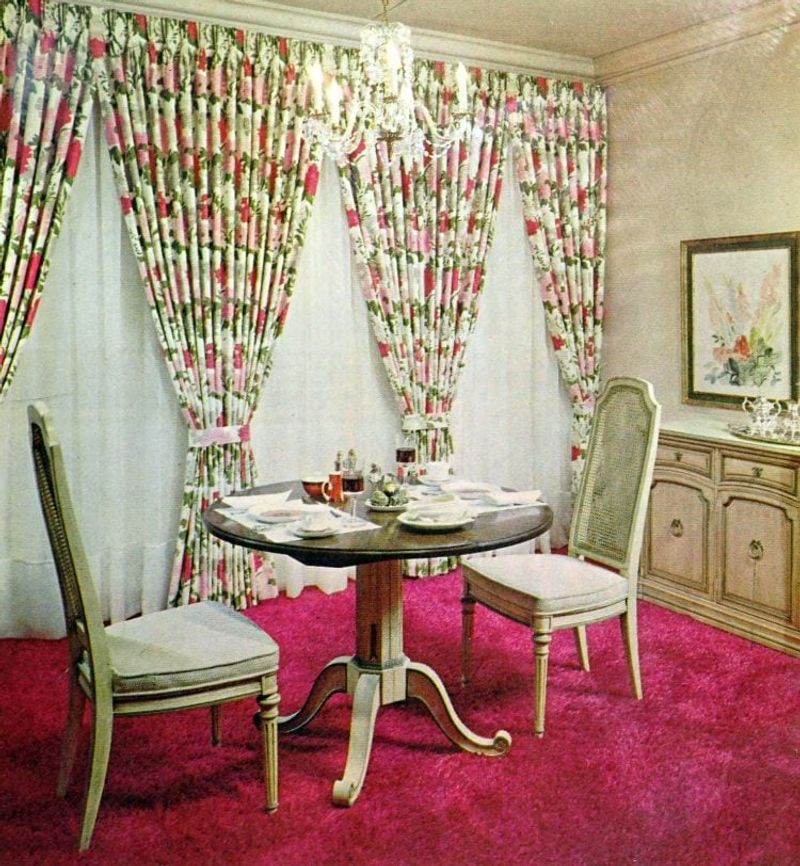
The elegance of heavy drapes was unmistakable in 1980s homes. These substantial curtains were often found in living rooms and bedrooms, providing privacy and insulation.
Made from rich fabrics like velvet or brocade, they added a sense of luxury and warmth.
While lighter, more modern window treatments are common today, heavy drapes can still impart a sense of grandeur and style, enhancing a room’s aesthetic with their opulence.
18. Built-in bookshelves
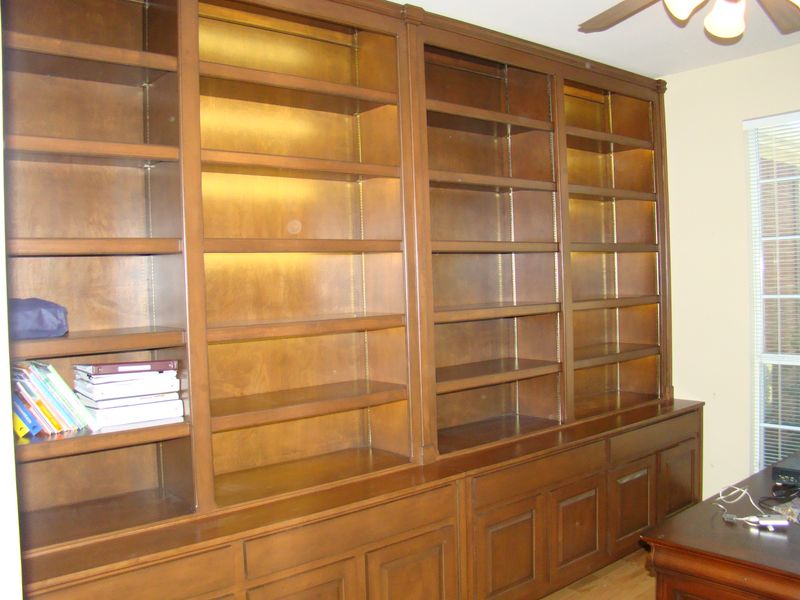
Bookshelves were more than just storage; they were a design feature. Built-in bookshelves were a staple of 1980s homes, combining functionality and style.
These custom shelves provided space for books, decor, and personal treasures, making them a focal point in living rooms or libraries.
Even though freestanding units are popular now, built-ins offer timeless elegance and efficiency, seamlessly integrating into the architecture of a home.
19. Sunken living rooms
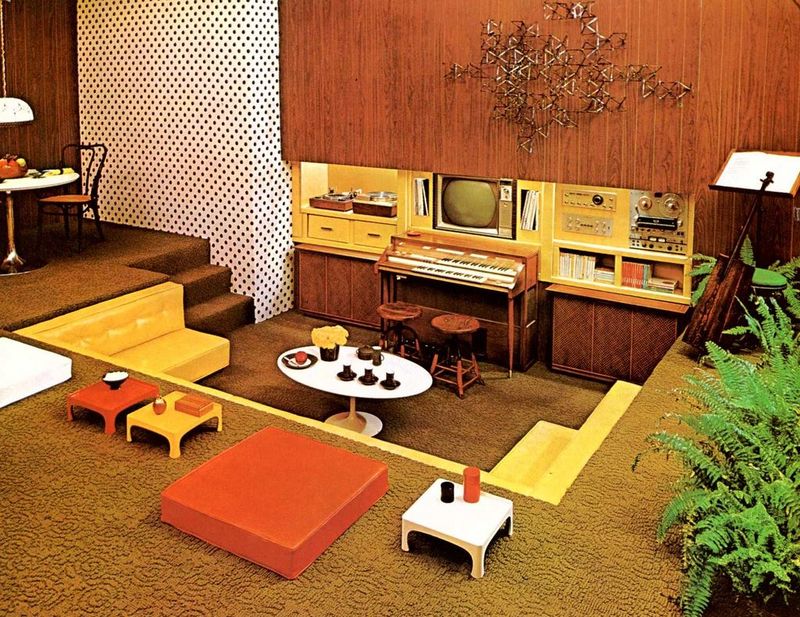
The allure of a sunken living room was undeniable in the 1980s. These architectural features created intimate spaces by lowering the seating area.
Often found in open-concept homes, they added depth and dimension to living rooms.
While not as common today, a sunken area can still provide a cozy and unique layout, perfect for conversation and relaxation. Incorporating this design can offer a playful nod to retro style.
20. Tile kitchen backsplashes
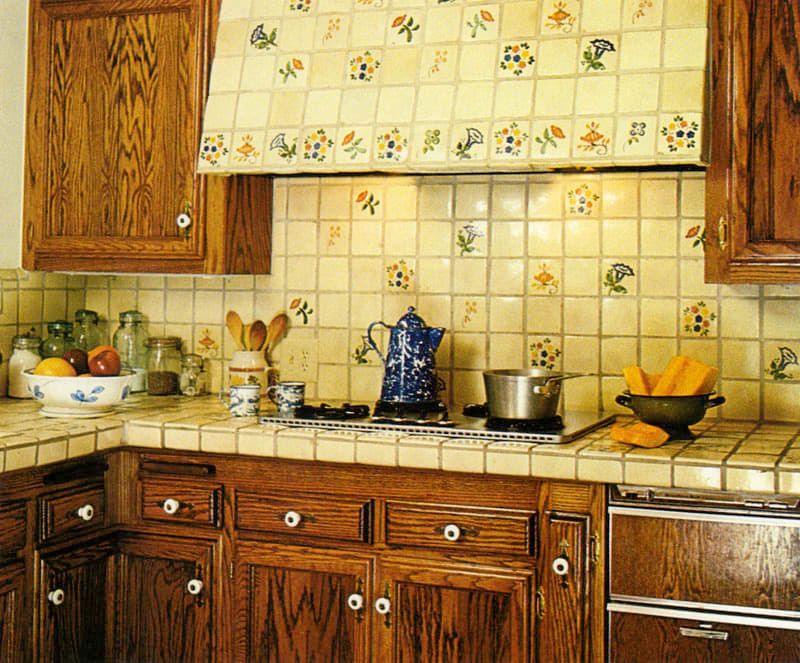
Kitchen design in the 1980s embraced color and pattern, particularly in tile backsplashes. These tiles added a decorative and protective element to walls, often featuring bold colors and intricate designs. From geometric patterns to floral motifs, they brought personality to kitchens.
While trends have shifted to more subdued designs, incorporating a colorful tile backsplash can create a vibrant focal point, echoing the expressive style of the 1980s.
21. Split-level layouts
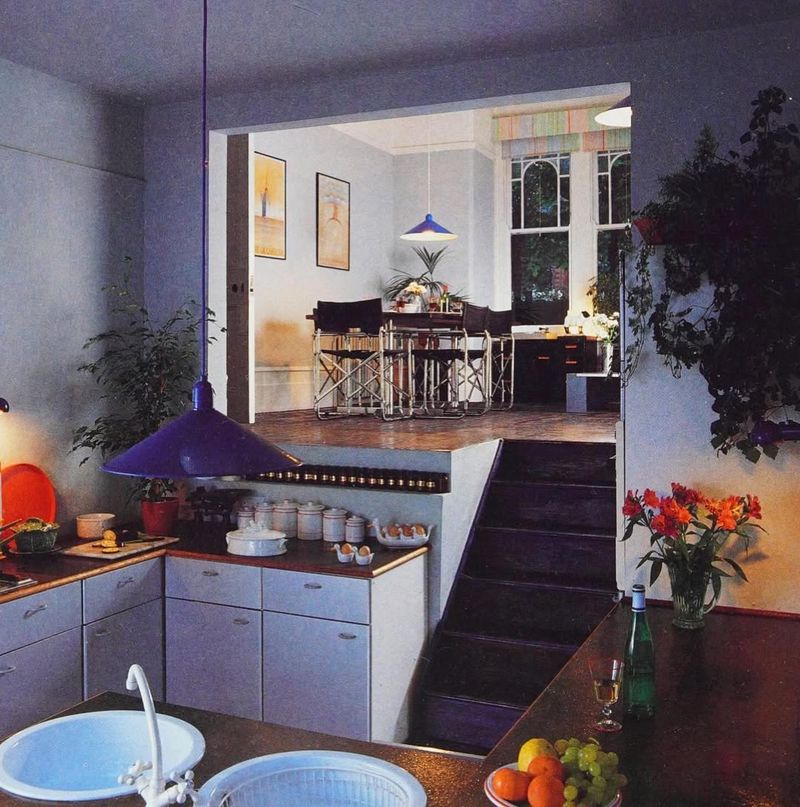
Split-level homes offered a distinctive architectural style in the 1980s. These multi-level homes featured staggered floors, creating a sense of separation and privacy. This layout was practical for maximizing space and providing distinct living areas.
While some find it dated, the split-level design can offer a unique and functional layout, perfect for families seeking defined spaces within their home. Embracing this style can bring a bit of nostalgia to modern living.
22. Round kitchen tables
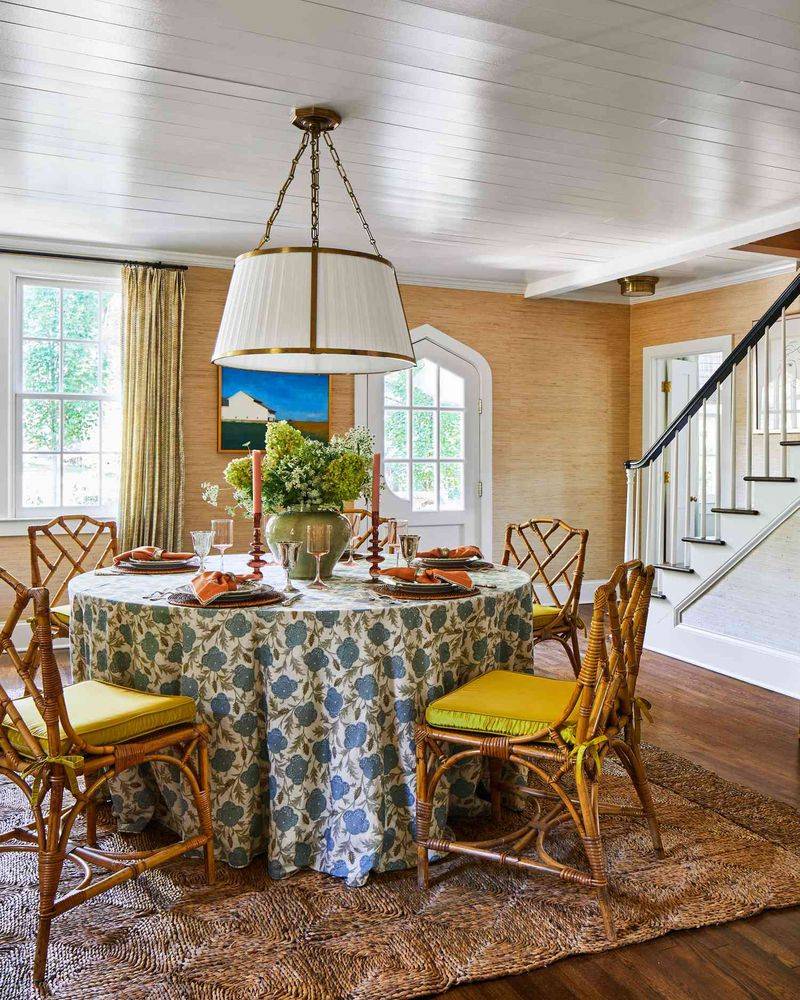
Round tables have a way of bringing people together, and in the 1980s they were a kitchen staple. These tables offered a practical and cozy dining solution, encouraging conversation and connection.
Often made from wood or laminate, they were versatile and suited various kitchen styles. While rectangular tables are more common now, a round table can still create an inviting and communal atmosphere, perfect for casual meals and gatherings.
23. Pop art decorations
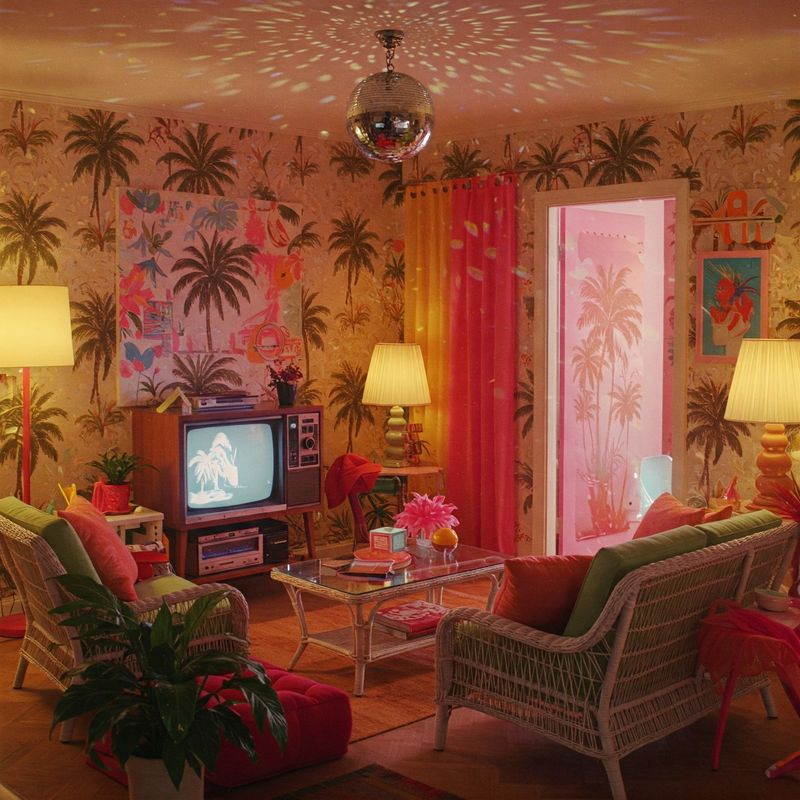
Art in the 1980s was anything but understated. Pop art decorations were popular, adding vibrant and bold visual elements to homes.
From prints of iconic figures to abstract designs, these pieces brought color and energy to walls. They were a reflection of the era’s dynamic cultural movements.
While trends have evolved, incorporating pop art can inject a sense of fun and creativity into contemporary spaces, making art accessible and engaging.
24. Green and brown color scheme
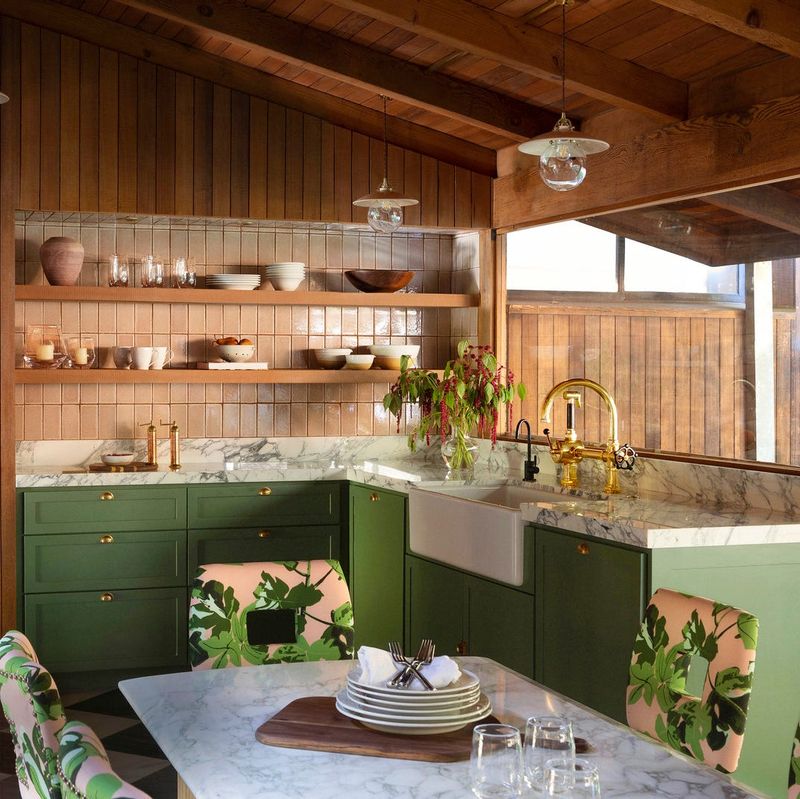
Colors speak volumes, and in the 1980s, green and brown were a favored combination. This earthy palette brought warmth and comfort to interiors, often seen in living rooms and kitchens.
Paired with natural materials like wood, it created a harmonious and inviting environment. While brighter colors are now popular, this classic combination can still provide a cozy and balanced aesthetic.
25. Bar stools with vinyl seats
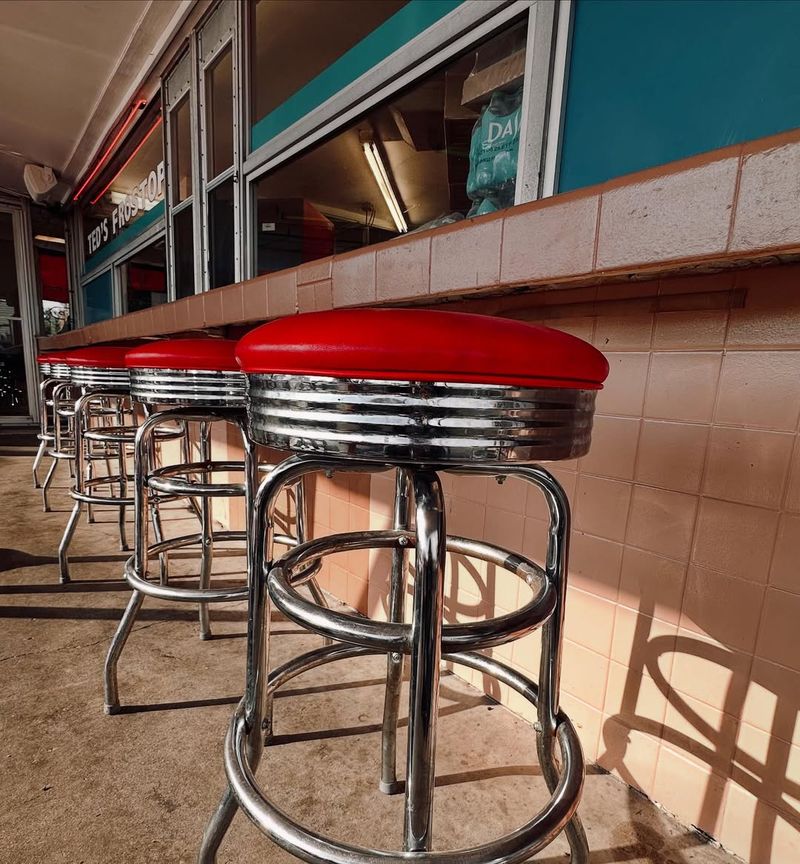
Seating in the 1980s often included bar stools with vinyl seats. These gleaming stools offered a practical and stylish seating solution, perfect for kitchen counters or home bars.
The vinyl material was easy to clean, making it ideal for busy households. While more natural materials are preferred now, vinyl bar stools can still bring a sense of retro charm and practicality to modern spaces.
26. Retro kitchen clocks
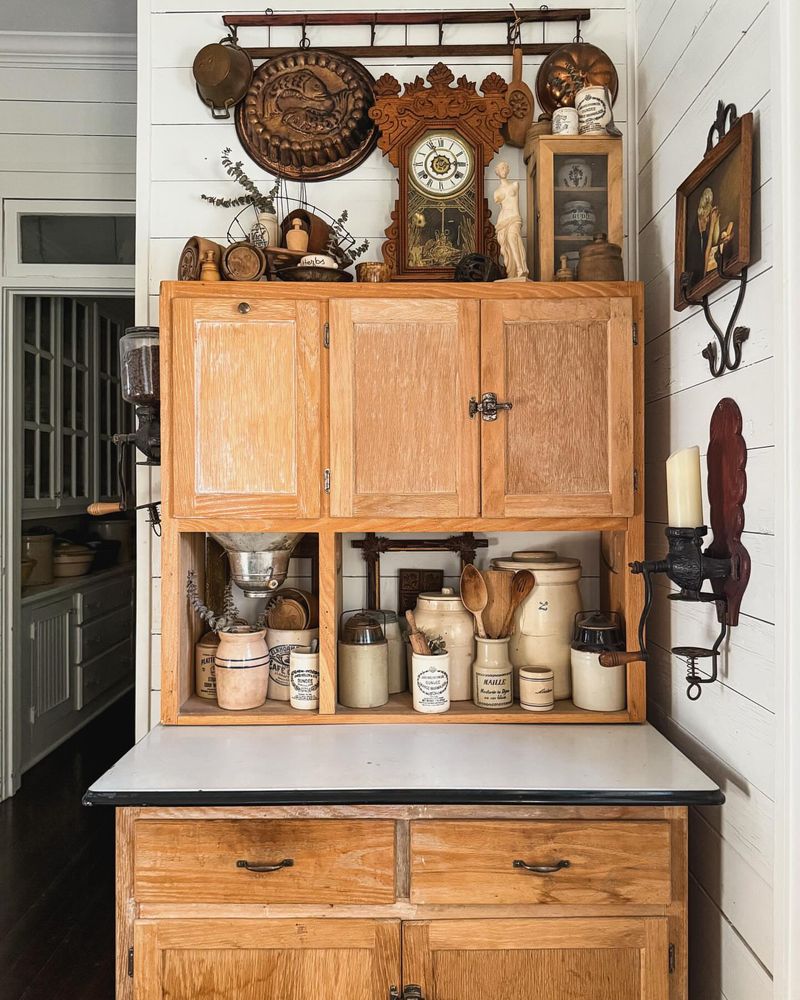
Timepieces in the 1980s were more than functional; they were design statements. Retro kitchen clocks with bold numbers and bright colors were common, adding a playful touch to walls.
Whether digital or analog, these clocks were as much about aesthetics as they were about timekeeping.
While technology has advanced, a retro clock can still introduce a sense of nostalgia and style, serving as a delightful conversation starter in any kitchen.
27. Brick fireplaces
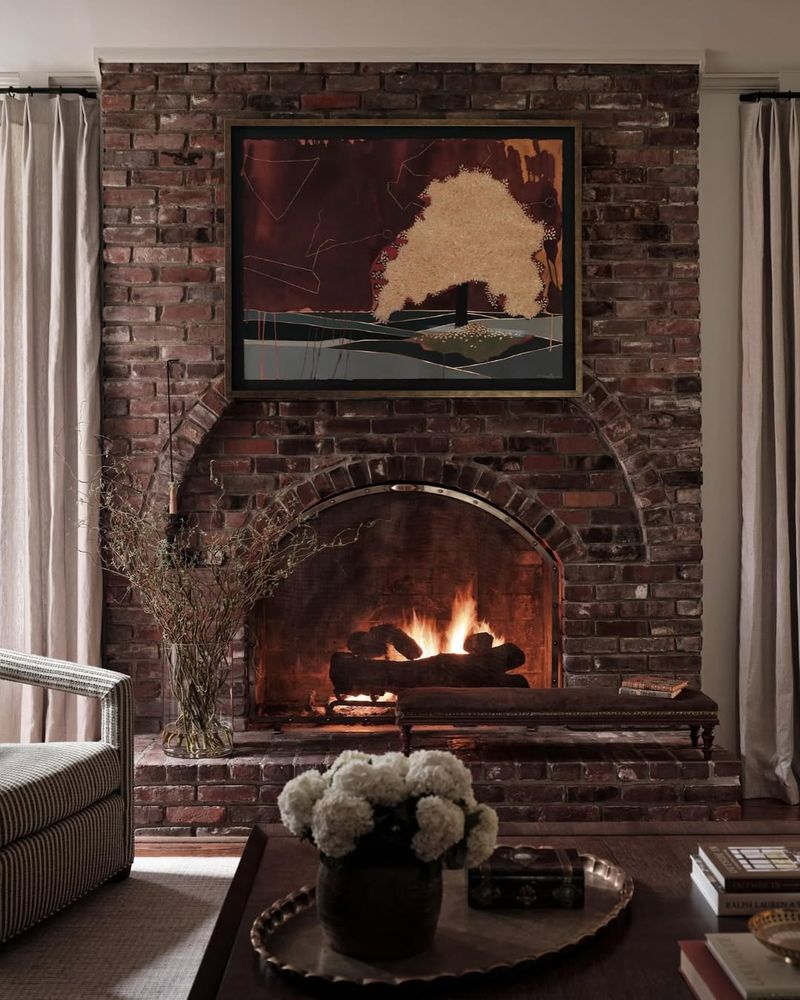
The centerpiece of many 1980s living rooms was the brick fireplace. These robust structures provided warmth and a rustic charm, often serving as the room’s focal point.
The textured brick offered a natural and earthy aesthetic, complementing various decor styles. Even though modern fireplaces are sleeker, a brick design can still provide a cozy and inviting atmosphere.
It’s perfect for gathering around during colder months.
28. Wall-mounted televisions
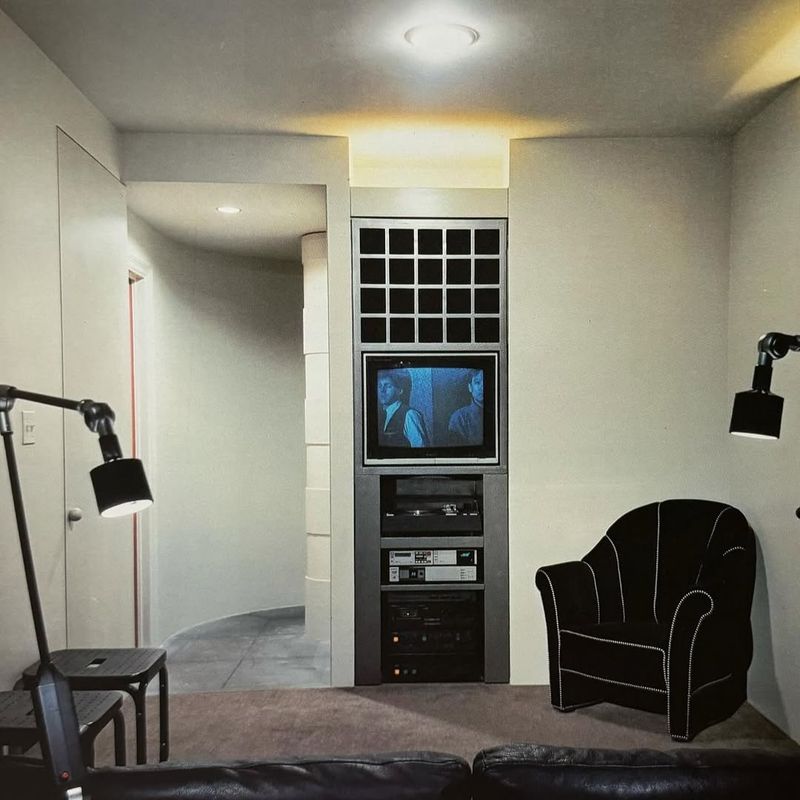
Technology began to revolutionize living rooms in the 1980s, with wall-mounted televisions leading the charge.
These TVs freed up floor space and offered a modern solution for entertainment setups. Often paired with wood-paneled walls, they were a practical feature in many homes.
While technology has rapidly advanced, the concept of wall-mounted screens endures, offering a streamlined and contemporary look that originated decades ago.
29. Tile or linoleum floors
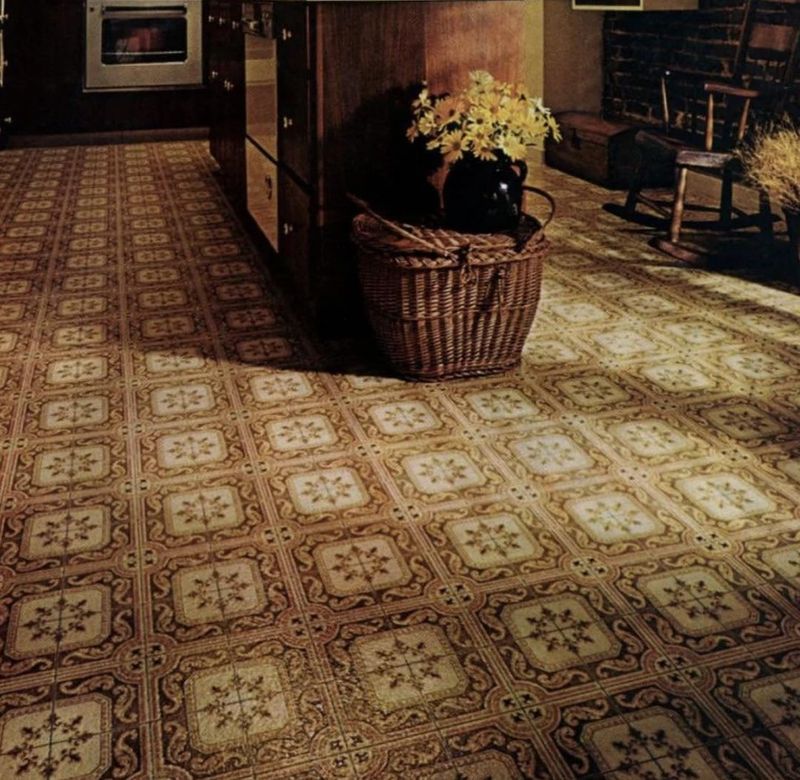
Flooring choices in the 1980s often included tile or linoleum, known for their durability and easy maintenance.
These materials offered a range of patterns and colors, from muted tones to vivid designs. They were a practical choice for kitchens and bathrooms, providing a waterproof surface.
While hardwood and other materials are favored now, incorporating a linoleum floor can add a touch of retro flair, celebrating the practicality and style of the past.
30. Neon signs and accents
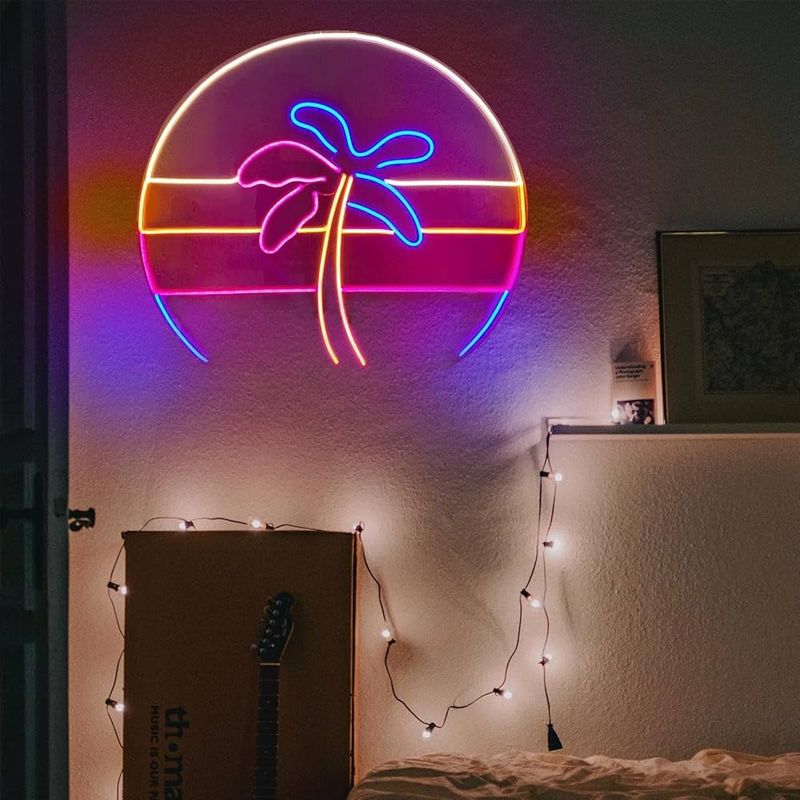
Vibrant and eye-catching, neon signs brought a pop of color to 1980s interiors. Commonly seen in bars and commercial spaces, they also made their way into homes.
These glowing accents were both decorative and functional, adding a playful energy to rooms. While trends have shifted towards more subtle lighting, a neon sign can still make a bold statement, perfectly capturing the nostalgic and lively spirit of the 1980s.
31. Faux fur throws
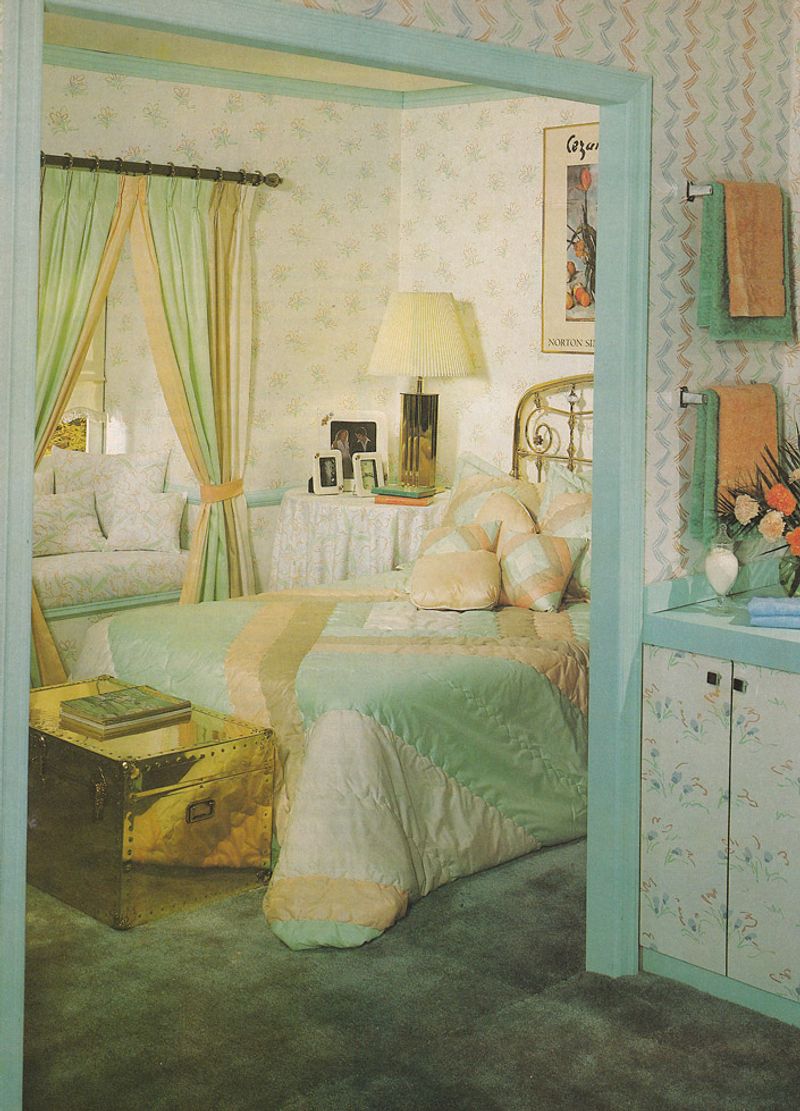
Adding a bit of luxury and warmth, faux fur throws were popular in the 1980s. These soft blankets provided comfort and style, often draped over sofas or beds.
They introduced texture and coziness, creating inviting spaces for relaxation. While design trends have evolved, a faux fur throw can still add a layer of elegance and comfort to modern interiors..
32. Large, oversized mirrors

The magic of mirrors lies in their ability to enhance space and light. In the 1980s, large oversized mirrors were a popular decor element.
These mirrors made rooms feel bigger and brighter, often serving as a focal point. Whether framed or unframed, they added a touch of elegance and drama.
While minimalist designs are now in vogue, a big mirror can still offer both functionality and style, reflecting the grandeur of past interiors.
33. Retro wallpaper borders
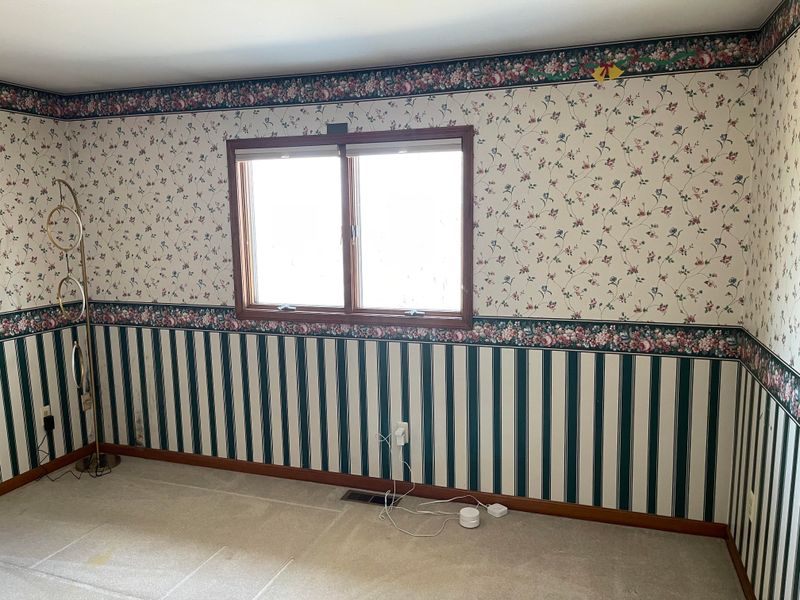
Borders were a common decorative element in the 1980s, adding detail and interest to plain walls. These wallpaper borders often featured patterns or motifs that complemented the room’s decor.
Placed at the top of walls or around windows, they offered a way to frame and enhance spaces. They’re less common today, but using a wallpaper border can introduce a vintage charm and a personal touch to modern interiors, harking back to past trends.
34. Vinyl record players
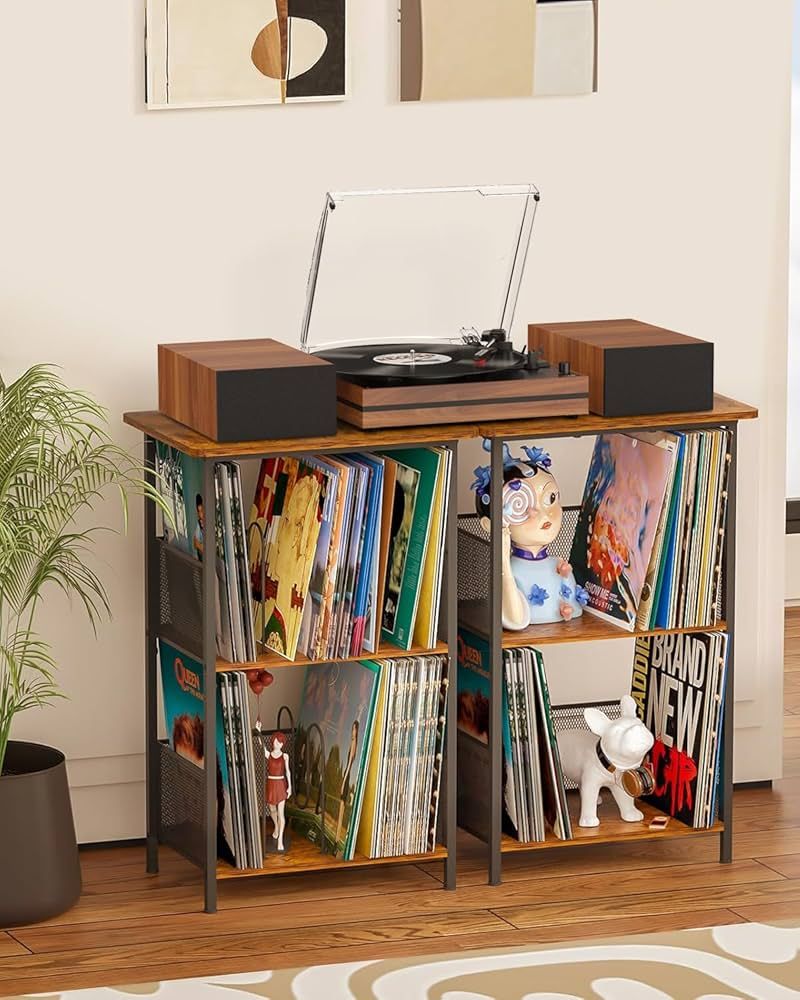
Music was an integral part of life in the 1980s, and vinyl record players were at the heart of this musical experience.
These players provided not just sound but also a tactile interaction with music. Often part of living room setups, they added a cool and sophisticated vibe.
While digital music is now predominant, a vinyl player can still offer a rich and retro listening experience, celebrating the timeless joy of analog sound.
35. Tufted furniture

Sofas and chairs with button tufting offered a plush look, adding texture and depth to interiors. The classic design of tufted pieces fit both formal and casual settings, making them versatile choices.
While modern designs favor sleek lines, tufted furniture can still bring elegance and style, blending the ornate with the contemporary for a timeless appeal.
36. Floral prints on cushions

Cushions adorned with floral prints were a common sight in 1980s homes. These patterns added a splash of color and personality to sofas and chairs, making spaces feel lively and welcoming.
Often paired with complementary fabrics, floral cushions were a simple way to update a room’s look. While minimalism is in vogue now, adding floral accents can introduce a playful and retro touch, infusing modern interiors with vintage charm.
37. Pastel bathroom fixtures

Bathrooms in the 1980s often featured pastel-hued fixtures, creating a soothing and stylish environment.
Sinks, bathtubs, and toilets in shades like pink, blue, or mint green were common. These colors added a soft vibe, balancing the boldness seen elsewhere in home design.
Incorporating pastel elements can bring a touch of retro elegance and serenity, transforming a bathroom into a unique and personalized space.
38. Galvanized steel light fixtures
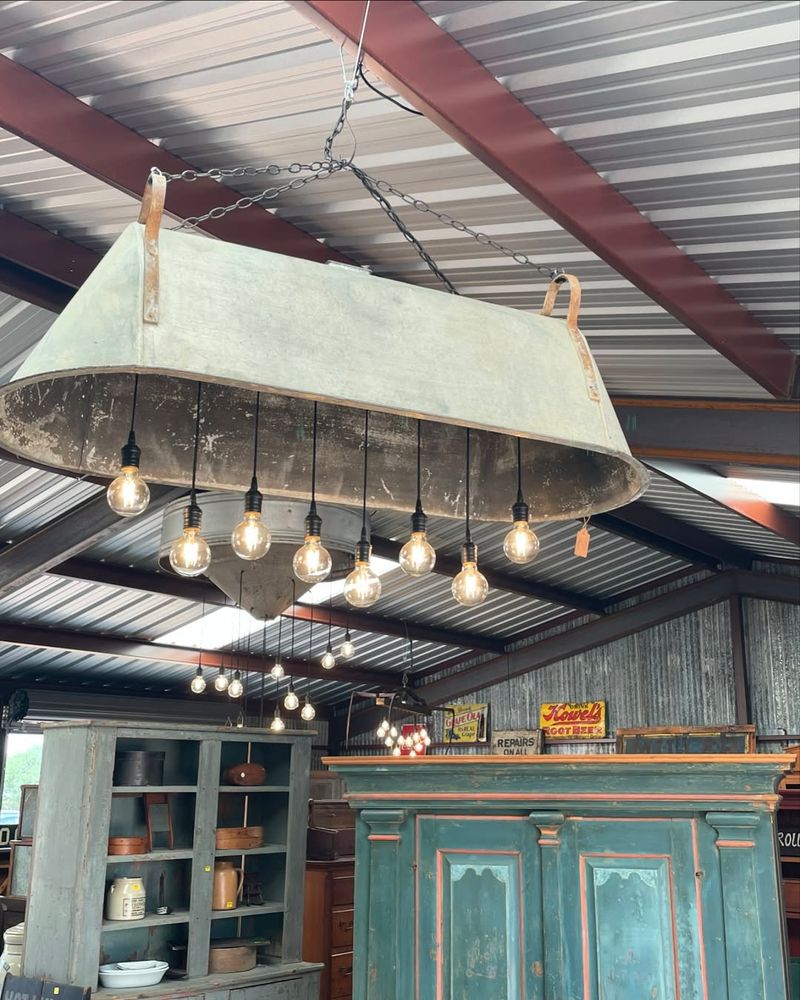
Incorporating industrial elements was a trend in the 1980s, with galvanized steel light fixtures leading the way.
These fixtures offered a sleek and modern look, their metallic finish adding a hint of industrial chic. Used in kitchens and dining areas, they complemented both contemporary and traditional settings.
While other materials are more popular now, galvanized steel can still add an edgy and stylish vibe, bringing a bit of retro-modern fusion to interiors.
39. Concrete patio floors
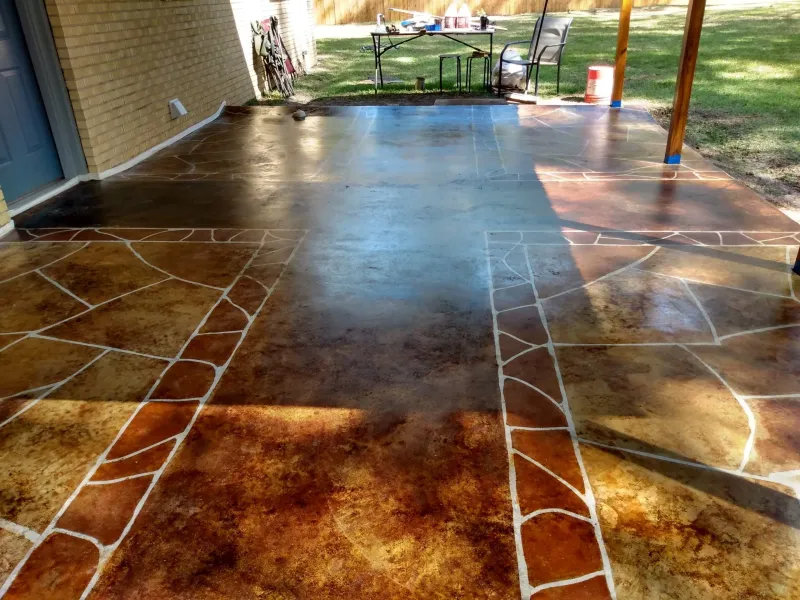
Outdoor living spaces in the 1980s often featured concrete patio floors. These surfaces provided durability and a clean aesthetic, perfect for entertaining or relaxing outdoors.
The neutral tone of concrete allowed for versatility in styling, easily paired with various outdoor furniture.
While wood and stone options are preferred today, a concrete patio can still offer a practical and minimalist solution, ideal for those appreciating a modern, yet vintage outdoor space.
40. Built-in wet bars
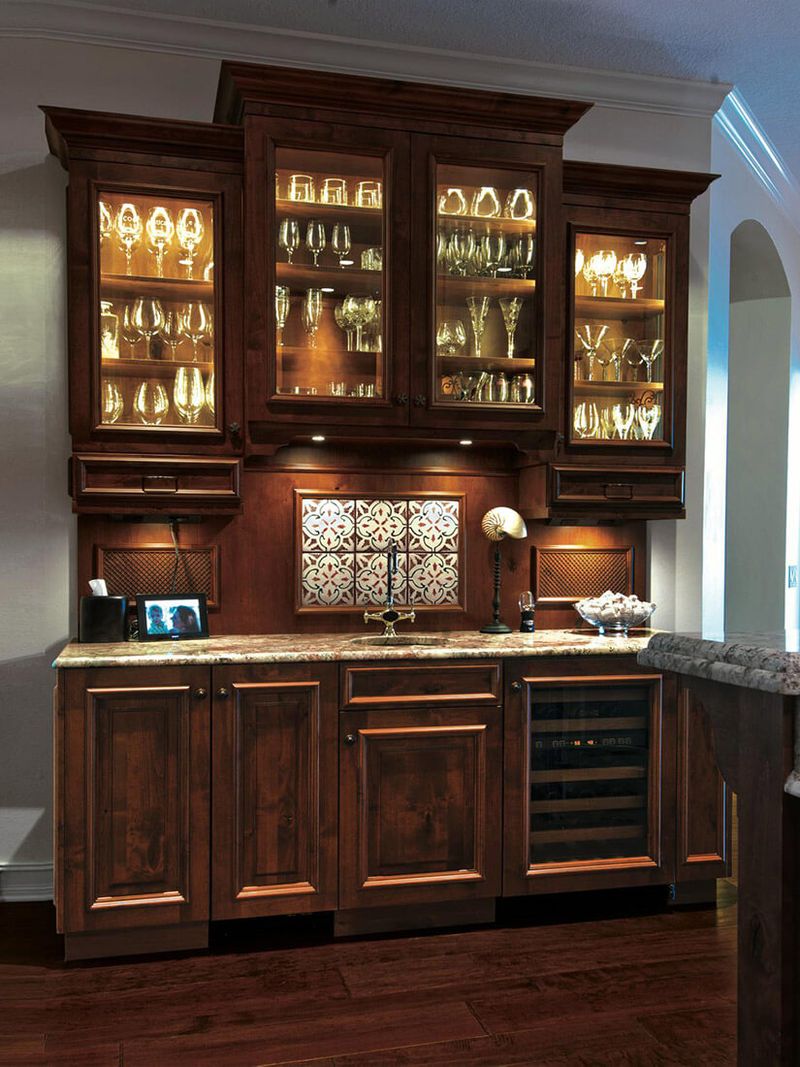
Entertaining was a key aspect of 1980s social life, and built-in wet bars were a popular home feature. These bars provided a dedicated space for preparing and serving drinks, often equipped with storage and a sink.
Found in living rooms or basements, they added a touch of luxury and convenience. While standalone bars are more common now, a built-in wet bar can still elevate a space, offering a sophisticated and nostalgic nod to past entertaining traditions.
